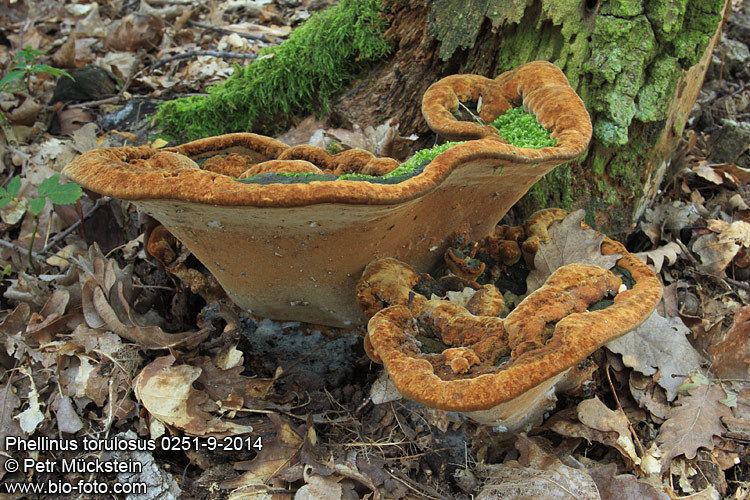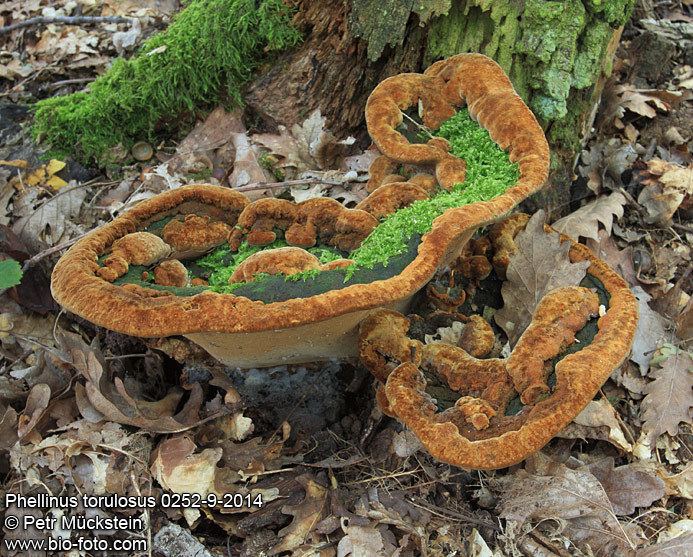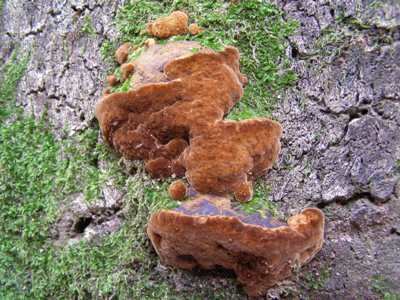Kingdom Fungi Phylum Basidiomycota Rank Species | Higher classification Fuscoporia | |
 | ||
Similar Fuscoporia, Phellinus pomaceus, Hymenochaetales, Hymenochaetaceae, Phellinus | ||
Fuscoporia torulosa phellinus torulosus tufted bracket
Fuscoporia torulosa is a species of bracket fungus in the Fuscoporia genus, family Hymenochaetaceae. A wood-decay fungus, it causes a white rot of heartwood in dead and living hardwood trees in Europe, and in coniferous trees in North America. Until recently, this species was known as Phellinus torulosus. However, a phylogenetic study in 2001 resulted in the Phellinus genus being split into five new genera, and P. torulosus being renamed to Fuscoporia torulosa.
Contents
- Fuscoporia torulosa phellinus torulosus tufted bracket
- Fuscoporia torulosa phellinus torulosus 4
- Description
- Microscopic features
- Habitat and distribution
- Modern identification techniques
- References

Fuscoporia torulosa phellinus torulosus 4
Description

The fruiting bodies of this species are semicircular or shell-shaped, with dimensions of 12–30 centimetres (4.7–11.8 in) broad by 4–10 centimetres (1.6–3.9 in) long. The brackets are typically 1–3 centimetres (0.39–1.18 in) thick, although it can be considerably thicker at the point of the broad attachment to the tree. Ryvarden and Gilbertson give maximum fruiting body dimensions of 46 centimetres (18 in) wide by 28 centimetres (11 in) long by 11 centimetres (4.3 in) thick. The fruiting body margin is rounded, and sometimes wavy, felt-like or tomentose on the flattened upper surface, which is typically orange-brown to rusty-brown in color. The color of the lower pore-bearing surface is cinnamon-, rust-, or olivaceous-brown, and there are 5 to 6 pores per millimeter.
Microscopic features

Basidiospores are ovoid or ellipsoid, hyaline, smooth, with dimensions of 4–6 × 3–4 µm. The basidia are club-shaped, 4-spored, with dimensions of 14–16 × 5–6 µm.
Habitat and distribution

Although its preferred host is Quercus, Fuscoporia torulosa has been reported growing on a variety of hardwood trees: Acer, Arbutus, Calluna, Castanea, Celtis, Ceratonia, Cercis, Cistus, Citrus, Cornus, Cratageus, Cydonia, Erica, Eucalyptus, Euonymus, Fagus, Fraxinus, Grevillea, Helianthemum, Juglans, Laurus, Malus, Melaleuca, Morus, Myrtus, Olea, Ostrya, Parrotia, Phillyrea, Pistacia, Pittosporium, Populus, Prunus, Punica, Pryus, Robinia, Rosa, Salix, Spartium, Ulex, Ulmus, Viburnum, Vitis, and, more rarely, conifers like Cedrus, Cupressus, Larix, Picea, and Pinus. Recently, F. torulosa has been reported as infecting more than 160 species of plants; most of these infections results in the plant's premature death.
Modern identification techniques

Production of visible fruiting bodies by F. torulosa does not happen until long after the tree has been initially infected, as it takes some time for the fungal mycelia to colonize the host. For this reason it often escapes detection until it is too late to save the tree. In 2007, a rapid detection method was reported that uses DNA technology, specifically the polymerase chain reaction, to enable detection of fungal mycelia in infected tissues in roughly six hours.
